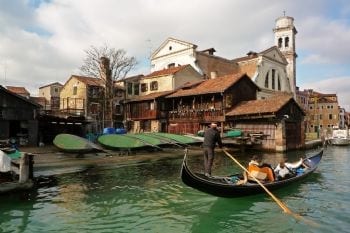I’m about to go on the Costa Fascinosa, Greek Isles cruise. The cruise begins and ends in Venice, which happens to be one of my favorite cities in the world. I wrote about it before in greater depth, but this time I thought I’d share with our readers a peak experience, I’m about to repeat.
As most anyone knows, the Gondola is the main mode of transportation in the magical city floating exquisitely on water, ornate palazos, deep historic sites and romance. There’s hardly anything as delightful, as soaking in the atmosphere, while one sits on these centuries old waster vehicles, being stirred by the singing Gondolier.
In the 16th century, there were 10,000 gondolas in Venice, 350 of which are still gracing the water, masterfully gliding under bridges, slightly tilted to the right by the Gondolier who traditionally stands at the back of the boat to the left.
Not just anyone can be a Gondolier mind you…this honor goes from father to son, for generation upon generation.
On my last trip we decided to take a tour to the Gondola boatyard, a place where these ancient beauties are repaired and new ones built, all executed in accordance with revered age old tradition.
When I found out more about the scientific precision required to build a gondola, I was bee-lining to the squero, my kids in tow, to watch how it was done.
We saw art and science combined as we watched one of the sleek black boats being put together. When our 8 day cruise was over, we headed straight back to the mini-lagoon like, wide spot in the canal, the Bacino Orseolo just north of Piazza san Marco. The gondola we watched the week before in it’s earlier stage, was still hard at being built, with a long way to go. We learnt that it takes 40-45 days to build the rare and very occasional new ones.
Every evening countless gondolas gather there, while the gondoliers lounge against the bacino’s railing, laughing and chatting. Some days you can see hundreds of these gorgeous boats side by side and it looks like a water bound parking lot.
The boats have been painted black since a 16th-century law&mdashto curb excess and gaudy extravagance, which spiraled out of control. The local artisans carefully craft the gondola from the seven types of wood&mdashmahogany, cherry, fir, walnut, oak, elm, and lime&mdashnecessary to give the shallow and asymmetrical boat its various characteristics.
After they puzzle all the pieces together, the painting, the ferro which is the iron symbol of the city affixed to the bow, and the forcole, the squiggly wooden post that serves as a complex oarlock.
Although this squero is the city&rsquos oldest and one of only three remaining, it works predominantly on maintenance and repair.
The new one we saw being built, ended up carrying us, all shiny, elegant and new, propelled by the strength of a single gondolier, no addition of new technology and a magical and fascinating recreation of the ancient beauty which sailed the waters for centuries.
– Hilit
image credit: tripomatic.com

